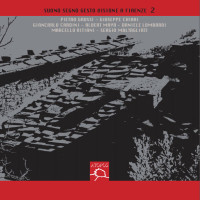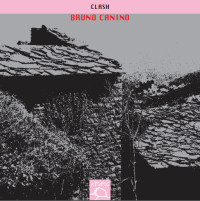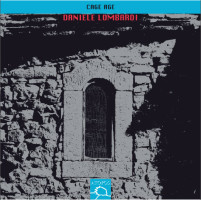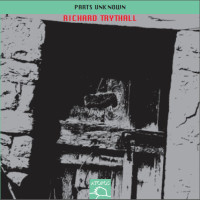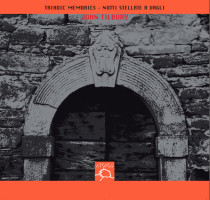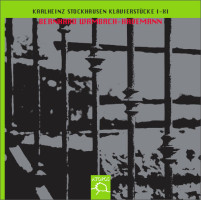Atopos Survey 1. / Italian Vacation 11. / Piano Factory 12.
|
Grant Chu Covell [March 2014.] Although Atopos (http://www.atoposmusic.com/catalogue_en.html) has been around for over a decade, I’ve only just discovered them. To make amends, this is likely to be the first of a two- or three-part visit. The emphasis is of course Italian, the sensibility suggesting various late-20th century Italians taking cues from European (Darmstadt) and American (Cage, Feldman, et al.) trends. Other releases are harder to pigeonhole: continental masters such as performer / composers Roberto Fabbriciani, JP Drouet and Vinko Globokar. We’ll look at piano-centered items now and pick up the thread started with our first Atopos mention.
“Suono Segno Gesto Visione a Firenze 2.” Pietro GROSSI: Sound life 4 (1979-85). Giuseppe CHIARI: Intervalli 2 and 3 (1950-56)a. Giancarlo CARDINI: Canti segreti (Sonata No. 2) (1989)b. Albert MAYR: So könnte es geschehen so oder ähnlich II (1978). Daniele LOMBARDI: Trasale Sospeso (1991)c. Marcello AITIANI: Canto dell’allegrezza II (1985). Sergio MALTAGLIATI: >Automated_Music 1.02 (2001). Daniele Lombardia, Giancarlo Cardinib, Gabriella Morellic, Giancarlo Simonaccic (pnos). Atopos ATP 010 (1 CD) (64:21) (http://www.atoposmusic.com/). This second part of a series reveals interesting musical happenings in late-20th-century Florence. Piano pieces by Chiari, Cardini and Lombardi sit alongside electronic pieces by Grossi, Mayr, Aitiani and Maltagliati. Chiari’s pair is quasi-minimal, serene but not restful. Maintaining a steady tempo, No. 2 walks through different chords over a common tone. No. 3’s single line methodically working through patterns suggests Tom Johnson. Unease lurks beneath Cardini’s placid chords and repeated notes. There are a few plucked strings; the continual return to static dissonance contributes to an ominous statement. Lombardi’s two-piano work is the most dynamic, the big chords and gestures of which suggest what comes after a significant event. Grossi’s ten-minute etude is a fast-paced electronic piece whose brightly colored sections undergo filtering and transformation reminiscent of early game sound effects. Atopos has a release completely dedicated to electronic innovator Grossi which I’ll report on in due course. Aitiani’s work appears to be fully synthesized with blippy pitches delineating a mysterious scale. Incorporating recorded sounds, Mayr has blended chorus, street noises and synthesized tones to create a modest portrait. Maltagliati manipulates water and chimes. The title suggests we hear the results of procedures and rules.
“Clash.” John CAGE: Etudes Nos. 4, 6 and 10 from Etudes Australes (1974-75). Franco DONATONI: Rima (1983). Niccolo CASTIGLIONI: 5 Pieces from Come io passo l’estate (1983). Marco DI BARI: Two studies: Self-similarity (1992), Refraction de Géométrie (1986). Mario CESA: Aiserlonenialant: 3 Dagherrotipi (1994?). Bruno CANINO: 2 Rondò (nd). Giovanni SOLLIMA: In Si (Matteo yes) (1991). Bruno Canino (pno). Atopos ATP 006 (1 CD, 79:33, rec. Jul. 7, 2001) (http://www.atoposmusic.com/). Canino’s ingenious program employs Cage to anchor an Italian piano anthology. Post-program analysis explains the program’s title, “Clash.” The first Etude Australe serves as a neutralizing warmup of random pitches and durations. Donatoni’s brilliant Rima asserts itself as highly structured, demanding exactitude as its cells twist and develop. The Castiglioni excerpts (five of ten) introduce nostalgia as wrong notes; unexpected gestures contradict naïve materials – Fellini meets Satie. After Di Bari’s technical studies, Cage’s casual raindrops suggest a world the Italians already discarded. Cesa and Canino make much of pianistic gestures, leaving nothing to chance. After the penultimate piece, Sollima’s tuneful pop song, Cage’s reappearance operates as grounding. I don’t think Canino meant to illustrate how contemporary Italian revolves around Cage or, indeed, ignores him. Instead he offers two intersecting orbits.
“Cage Age.” John CAGE: Suite for Toy Piano (1948); In the name of the holocaust (1942); Two Pieces (1946); A Room (1943); Music for Piano 69-84 (1956); 4’33” (1952); Variations IV (1963)*. Henry COWELL: Dynamic Motion (1914). Daniele Lombardi* (pno), Ana Spasic* (sop), Jonathan Faralli* (perc), Jonas Daverio* (toy piano), Mauro Forte* (coordination and sound). Atopos ATP 021 (1 CD, 75:01, rec. Oct. 22, 2012) (http://www.atoposmusic.com/). For the 2012 Cage centenary, pianist / composer Lombardi offers representative early to middle works, contrasting semi-melodic and rhythmic works with randomness. There are no late works, nothing with time brackets or organized constellations such as Music for Changes. A short piece by Cowell demonstrates the predecessor to Cage’s keyboard technique and preparations. This unsilent 4’33” appears to be an amplified resonant space with barely audible outdoor sounds. The realization of Variations IV, a tribute to Cage reflecting Lombardi’s friendship, lasting nearly 23 minutes, is rich with sampled radio and recordings. The pianists, vocalist and percussionist work in concentrated blocks, with the mood changing slowly from carefree to restrained. A bit of later Cage would have shown there was more to Cage than just piano preparations, silence and lively chance.
Richard TRYTHALL: Parts Unknown (1989-91). Richard Trythall (pno). Atopos ATP 001 (1 CD, 55:28, rec. Dec. 4, 1999) (http://www.atoposmusic.com/). Based in Rome since 1964, Trythall premiered works by Donatoni, Castiglioni and Clementi. Since 1974, he has guided the American Academy in Rome’s musical presence. Recorded live in December 1999 by Trythall himself, the 55-minute long 12-movement suite is a monumental statement of different styles and moods, akin to the Baroque suites of Bach or Couperin. The sections are: Prologue, Soliloquy, Intermezzo, Toccata, Adagio, Allegro, Waltz, Fantasy, Étude, Senza Tempo, Melodramma [sic], and Night Rider. Trythall suggests that the dozen can be split into halves, or also categorized into four groups of lyric narratives, dramatic fantasies, etudes and dances. The music embraces a tonal quasi-improvisatory jazz-infused idiom. Trythall indicates the work had a multi-year gestation, with parts feeling as if they were conceived on the spot. One might confuse this with Jarrett heard from another room. There are hints of the vast piano repertoire; a strong right hand is required. The pieces surprise with abrupt changes and unpredictable rhythmic drive. A YouTube clip reveals Trythall’s commanding technique.
Morton FELDMAN: Triadic Memories (1981). Howard SKEMPTON: Notti stellate a Vagli (2008). John Tilbury (pno). Atopos ATP 012/013 (2 CDs, 75:18 + 50:11, rec. Jun. 10, 2008) (http://www.atoposmusic.com/). With regard to Feldman’s larger works, his loyal fans strike postures of awe. The composer’s longer pieces arise in tranquility, beauteous soft tones and gently repeated patterns. Tilbury subtly varies internal dynamics, shading accents here and there. This is casual and colloquial Feldman, less elevated than most. Because Tilbury has added personality and unaccustomed contours, Feldman’s intentional changes of mood and register are more difficult to notice. However, it does feel as if Tilbury settles into the more customary, glassier Feldman performance style somewhere around the 25-minute mark. He does appear to slow more reflectively towards the end. To compare with a favorite among other Triadic recordings: Tilbury’s resonance may not be as magical as Louis Goldstein’s. It may be that Goldstein has a better piano and piano technician handy. However Tilbury offers more ambiance especially if you don’t need your Feldman hermetically sealed. Skempton’s “Starry Nights at Vagli” is Feldman-like. Commissioned by Fondazione Atopos, it was intended to accompany Triadic Memories. Vagli is in Tuscany, and the piece conveys the night and stars in the sky. As with Feldman, gestures are sparse; however, the implied harmony and contours are completely different. We hear gentle single notes taking a relaxed even haphazard walk. Atopos recorded Tilbury playing Feldman and Skempton in England (London: St John’s Smith Sq.), not in Italy as are most other Atopos’ productions. Feldman fans know this is Tilbury’s second go at Triadic Memories. He’s apparently happier with this recording than his prior. Congrats to Atopos for helping the stars align. Morton Feldman: Triadic Memories (1981)
Karlheinz STOCKHAUSEN: Klavierstück I (1952-53); Klavierstück II (1952-53); Klavierstück III (1952-53); Klavierstück IV (1952-53); Klavierstück V (1954); Klavierstück VI (1954-61); Klavierstück VII (1954); Klavierstück VIII (1954); Klavierstück IX (1954/61); Klavierstück X (1954/61); two versions of Klavierstück XI (1956). Bernhard Wambach-Havemann (pno). Atopos ATP 19/20 (2 CDs, 53:42 + 53:16, rec. Oct. 1, 2012) (http://www.atoposmusic.com/). Does Stockhausen endure? Do these pieces still captivate? How do you count 142 repetitions? Back in the day, the first four Klavierstücke represented the culmination of composer-controlled details and structures. The later Klavierstücke led to performer-determined structures. At age 64, more than a quarter-century since he first studied and performed them, Wambach-Havemann returns to see how they hold up. This may be the most recent recording of these pieces. It might also be the only set still easy to obtain. I to IV are fiendishly precise. V to VIII incorporate resonance and freer pulse as Stockhausen became more attuned to performance physicality. IX has that famous repeating four-note chord (C# F# G C) the individual tones of which are meant to wriggle under inevitably inconsistent finger pressure. XI is open, permitting the performer to move from any section to any other. Even when following along, one feels as if there he’s listening to impenetrable mysteries. The entire collection gravitates towards the pleasant shock of IX’s repeated chord. Wambach-Havemann certainly knows his way around. Comparing to an older classic recorded in 1965, Aloys Kontarsky may have offered more chiseled recklessness – an adventurer’s kind of Stockhausen. Wambach’s dynamics are not as aggressive as Kontarsky’s and all the notes are more clearly articulated. Both are well recorded and it’s easy to hear sustained resonance and when notes in a chord are released at different times. Wambach offers contours more suggestive of well-executed Webern or Feldman whereas Kontarsky provides Darmstadt ice. The second, more rewarding disc features two versions of the mobile XI, the famous IX and a nearly half-hour X. Wambach’s very loose IX suggests Satie not in the repetitions but rather the vapor of the higher notes that follow. Kontarsky’s IX is solemn, Wambach more the traveler recounting a marvelous voyage. Similarly the demanding X is rhapsodic and capricious. Does Wambach wear gloves to protect his hands against the bruising clusters and frequent glissandos? Track timings are deceptive as much here starts with silence, II for example beginning with 18 seconds of quiet. Karlheinz Stockhausen: Klavierstücke I – XI
Aitiani, Cage, Canino, Cardini, Castiglioni, Cesa, Chiari, Cowell, Donatoni, Feldman, Lombardi, Maltagliati, Mayr, P Grossi, Skempton, Sollima, Stockhausen, Trythall
[More
Aitiani, Cage, Canino, Cardini, Castiglioni, Cesa, Chiari, Cowell, Donatoni, Feldman, Lombardi, Maltagliati, Mayr, P Grossi, Skempton, Sollima, Stockhausen, Trythall]
[Previous Article:
James Erber’s The “Traces” Cycle]
[Next Article:
Personal Discoveries: Mieczysław Weinberg]
|
